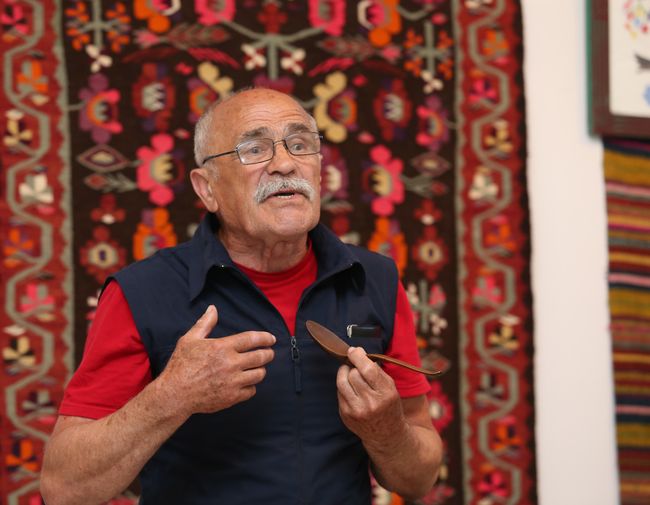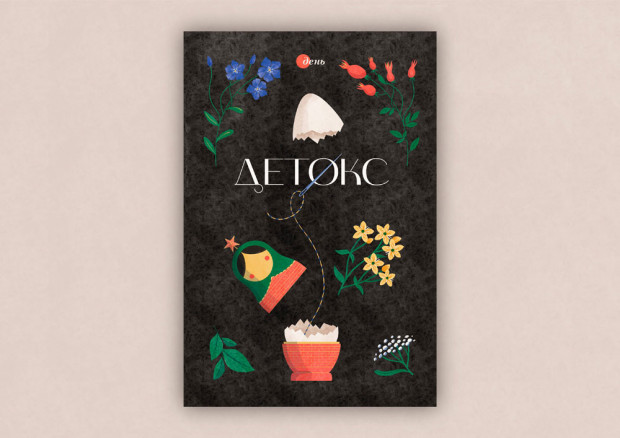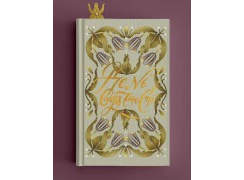Folk art ABC
Ray of Resurrection, an album about artist Vasyl Parakhin and his unique painting school, has seen light
The book, which has been prepared for 10 years, features fairytale birds, fantastic plants, and chimerical ornaments, as well as many photos and several academic texts. Recently the publication was presented at the National Center of Folk Culture “Ivan Honchar Museum.” The collection was published by the culture figures of Volyn with the assistance of local authorities.
Vasyl Parakhin resides in the farmstead Cherukovatytsia on the border between Volyn and Lviv oblasts. The artist mastered the craft of weaving with pine root and straw, wood and stone carving, weaving, embroidery, and he creates tens of original works. Parakhin also passes his craft to numerous pupils. In a non-specialized school in the neighboring villages Zhuravnyky the artist organized a folk art studio, where he teaches children to paint and draw following the ancient traditions.
“Children work for three to four hours a day, even when the temperature is below zero. When they feel cold, we do warming-up exercises and proceed,” Vasyl Parakhin smiles. His pupils paint with gouache, draw with chalk, pens, and pencils, they weave tapestry, and do some wood carving.
In such a way Vasyl Parakhin turns the farmstead Cherukovatytsia into an open-air museum, with samples of Ukrainian architecture, wooden sculpture, and forged objects being the items. During 40 years of his work the artist has saved hundreds of folk artists’ works from destruction. In the photos by well-known Volyn photographer Viktor Chukhrai that are present in the book Ray of Resurrection the readers can see how Vasyl Parakhin works with schoolchildren, how he develops Cherukovatytsia.
The album compiler Zoia Navrotska is impressed with the way the artist works with schoolchildren. “I was preparing the exhibit ‘Tree’ about folk art in modern Volyn and came to Parakhin. He agreed to give some of his pupils’ works, and we went to the school where he was teaching. On our way we picked up a girl who was gathering onions with her mother at a vegetable garden. When we came to the school, I didn’t see any works. In the walls there were pictures of Cheburashka, plastic sunflowers. Finally, we entered a tiny classroom, which contained numerous works he creates with his pupils. And seeing them gave me the chills – so impressed I was. Then Parakhin asked the girl to draw a horse on the board. The girl started to draw with confident moves, like a conductor. And she drew a real horse as a result, it was not just doodling. That was what I needed. We selected the works for the exhibit, started to cooperate, and I came up with a desire to fix the ideas professed by Parakhin in space,” Navrotska recalls.
The master from Cherukovatytsia emphasizes that human soul is closely connected with the national environment. Therefore the ruination of the former causes the degradation of the latter. A Doctor of Arts, one of the authors of the album Rays of Resurrection Mykhailo Selivachov asserts: “Vasyl Parakhin showed that folk art can be relied not on souvenir production, but real tradition that can be applied in everyday life. Parakhin as well provided a theoretical ground for the alternative nature of folk and academic art. Each of these streams has laws of their own, they get mutually inspired, influence one another, and can coexist in any healthy culture.”
This is the second book about the creative work of Vasyl Parakhin. The first one, A Line in Traditional Folk Art, was published about ten years ago and its target audience was teachers. Rays of Resurrection highlights more the personality of Vasyl Parakin and the surrounding that shaped it. “The new book is only a tip of the iceberg. This project has been ‘brewed’ for 10 years, and during this period of time we have organized five huge folk art exhibits and created several expositions,” the compiler of the album Zoia Navrotska shares, “For Vasyl Parakhin the most important thing is to preserve the tradition and adapt it in modern environment. With his work the artist has proved that traditional art can exist and develop today.”
Newspaper output №:
№38, (2015)Section
Time Out





